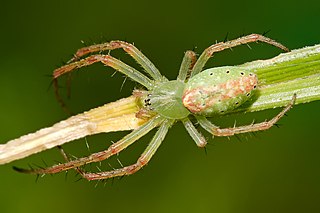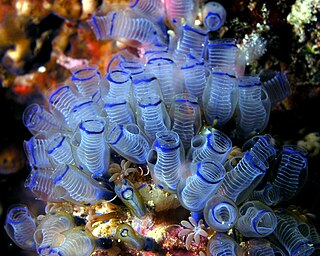
The Salmon-crested cockatoo, also known as the Moluccan cockatoo, is a cockatoo endemic to the Seram archipelago in eastern Indonesia. At a height of up to 46–52 cm and weight of up to 850 g, it is among the largest of the white cockatoos. The female is larger than the male on average. It has white-pink feathers with a definite peachy glow, a slight yellow on the underwing and underside of the tail feathers and a large retractable recumbent crest which it raises when threatened, revealing hitherto concealed bright red-orange plumes to frighten potential attackers. It may also be raised in excitement or in other 'emotional' displays. Some describe the crest as "flamingo-colored." It also has one of the louder calls in the parrot world and in captivity is a capable mimic.

The smallfin gulper shark is a medium-sized deepwater dogfish in the Centrophoridae family.

Cyrtophora, the tent-web spiders, although technically orb-web spiders, do not build orb webs. Their tent-like, highly complex non-sticky web is sometimes considered a precursor of the simplified orb web. These webs are aligned horizontally, with a network of supporting threads above them. These spiders often live in colonies. Females have a body length of mostly about 10 mm.

The bare-backed fruit bat is a fruit bat in the family Pteropodidae.

The blue-winged pitta is a passerine bird in the family Pittidae native to Australia and Southeast Asia. It forms a superspecies with three other pittas, the Indian pitta, the fairy pitta and the mangrove pitta. A colourful bird, it has a black head with a buff stripe above the eye, a white collar, greenish upper parts, blue wings, buff underparts and a reddish vent area. Its range extends from India to Malaysia, Indonesia, southern China and the Philippines. Its habitat is moist woodland, parks and gardens and it avoids dense forest. It feeds mainly on insects and worms. It breeds in the spring, building an untidy spherical nest on the ground, often near water and between tree roots. A clutch of about five eggs is laid and incubated by both parents, hatching after about sixteen days.

The Moluccan naked-backed fruit bat is a species of megabat in the family Pteropodidae. It is found in the Maluku Islands and Western New Guinea of Indonesia, Papua New Guinea, and Australia.
Padenia is a genus of moths in the subfamily Arctiinae described by Moore in 1882.

Clavelina moluccensis, common name bluebell tunicate, blue bell tunicate, or Blue Sea Squirt is a species of tunicate, in the genus Clavelina. Like all ascidians, these sessile animals are filter feeders.
Padenia acutifascia is a moth of the subfamily Arctiinae. It was described by Joseph de Joannis in 1928. It is found in Vietnam.
Padenia bifasciatus is a moth of the subfamily Arctiinae. It was described by Rothschild in 1912. It is found in New Guinea.
Padenia cupreifascia is a moth of the subfamily Arctiinae. It was described by Rothschild in 1912. It is found on Sumbawa.
Padenia intermedia is a moth of the subfamily Arctiinae. It was described by van Eecke in 1929. It is found on Buru.
Padenia sordida is a moth of the subfamily Arctiinae. It was described by Rothschild in 1912. It is found in Malaysia.
Padenia transversa is a moth of the subfamily Arctiinae. It was described by Francis Walker in 1854. It is found in Sri Lanka and on the Andamans.
Padenia triseparata is a moth of the subfamily Arctiinae. It was described by Hubert Robert Debauche in 1938. It is found on Sulawesi.
Padenodes cuprizona is a moth of the family Erebidae. It was described by George Hampson in 1914. It is found on New Guinea and Australia.

Xylocarpus moluccensis is a tree in the family Meliaceae. It is named for the Moluccas archipelago.
The Cisthenina are a subtribe of lichen moths in the family Erebidae, currently containing 428 described species.
The Nudariina are a subtribe of lichen moths in the family Erebidae.

Cyrtophora moluccensis is a tent-web spider in the orb-weaver family. It is commonly known as the tent spider or dome-web spider, and is native to India, Japan, Indonesia, Papua New Guinea, Australia, Fiji, and Tonga. It is often found in disturbed or open habitats from coasts to forest and mountainous interiors.










